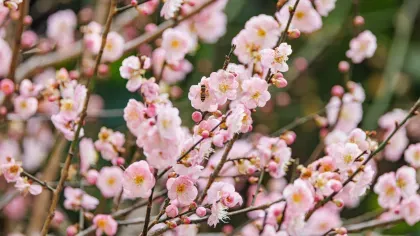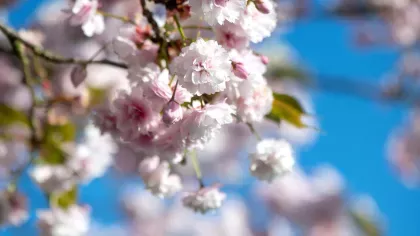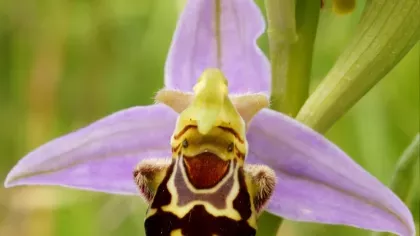23 December 2013
How did plants evolve frost hardiness?
Rafaël Govaerts from Kew's Herbarium describes the discovery of three key traits instrumental to the radiation of flowering plants into freezing environments. The results of the study were recently published online in the journal Nature and will appear in the print issue on 6 February.

It seems appropriate, it being mid-winter, to write about how plants evolved to cope with frost. Many of us interested in growing exotic plants worry at this time of year whether our prized plants will survive the winter - frosty mornings, snow and ice all have a detrimental impact on plant cells and tissues. However, despite this, many plant species have adapted to cope with freezing conditions and this raises a number of questions. Together with researchers worldwide, we looked at a large sample of plants to find out how frost hardiness evolved and to identify the key adaptations that allowed early flowering plants (angiosperms) to cope with the cold. We found that three key characteristics for surviving in freezing environments evolved before species diversification in these areas began, thus paving the way for early angiosperms to spread into colder environments. The results were recently published in the journal Nature [1].
Data collation and analysis
In total, 49,064 species were used in the analysis, and information on life form, anatomy and phenology (flowering times) was combined with spatial and climate data to enable a large-scale analysis of the interaction of traits and climate. In order to model these interactions in an evolutionary context, a phylogenetic tree showing the evolutionary relationships of over 30,000 species was constructed. This tree was dated, so that the timing of the evolution of cold-adapted traits and shifts to cold environments in different plant groups could be investigated.
The life form data was largely extracted from the World Checklist of Selected Plant Families database. This provides a large sample of plants in different plant families, and high quality data that are essential for reliable analysis. This is because each family is compiled with the input of experts worldwide and all the online data has been peer reviewed. The entries, including the life form, have been compiled from numerous published and unpublished sources, which are listed in the references for each name.
Three keys to survival
The first key to survival in freezing environments that we discovered to be important was the size of the pipes that transport the water. The smaller they are, the less chance that they will burst when they freeze. The first group of plants to flourish when the climate became colder therefore contained those species that already had a small-diameter water transportation system.
The second key is related to preventing loss of water during cold periods. Woody plants therefore evolved to shed their leaves and shut down all systems to prevent water loss. It seems obvious to us now, but for early flowering plants this was an exciting new development. Today many trees in seasonally dry tropical regions also shed their leaves. We found that this trait was predominant in some lineages of early flowering plants, giving them a competitive advantage over evergreen plants as they moved into the colder environments.
The third key is about hiding during cold periods. Herbaceous species largely avoid freezing by disposing of cheaply constructed above-ground tissue and overwintering as underground storage organs or seeds. Annuals, biennials and perennials are common life forms in temperate regions. They are, however, uncommon in the wet tropics. This is why the herbaceous border and carpet bedding are such typical English garden features, not easily replicated in tropical gardens. The herbaceous habit of some the earliest angiosperms therefore also conferred a competitive advantage and enabled these plants to populate the colder environments.
From all this we can conclude that freezing environments were largely colonised by deciduous woody plants and a subset of lineages that were already herbaceous or, if woody, had small water conductors before they encountered freezing. Even though the transition between herbaceous and woody growth forms is relatively easy genetically, movement into colder environments by existing lineages seems to have been more significant than a change in growth form. We gardeners already know that we can keep tropical plants over winter by storing their seeds or protecting tubers and rhizomes either by mulching or digging them up. Perhaps we should try and find some more tropical trees with small water conducting cells. Who knows, we may start a new gardening trend based on scientific findings!
References
1. Zanne, A.E., Tank, D.C., Cornwell, W.K., Eastman, J.M., Smith, S.A., FitzJohn, R.G., McGlinn, D.J., O’Meara, B.C., Moles, A.T., Reich, P.B., Royer, D.L., Soltis, D.E., Stevens, P.F., Westoby, M., Wright, I.J., Aarssen, L., Bertin, R.I., Calaminus, A., Govaerts, R., Hemmings, F., Leishman, M.R., Oleksyn, J., Soltis, P.S., Swenson, N.G., Warman, L. & Beaulieu, J.M. (2013). Three keys to the radiation of angiosperms into freezing environments. Nature. Published online 22 December 2013 and will appear in a print issue on 6 February.



